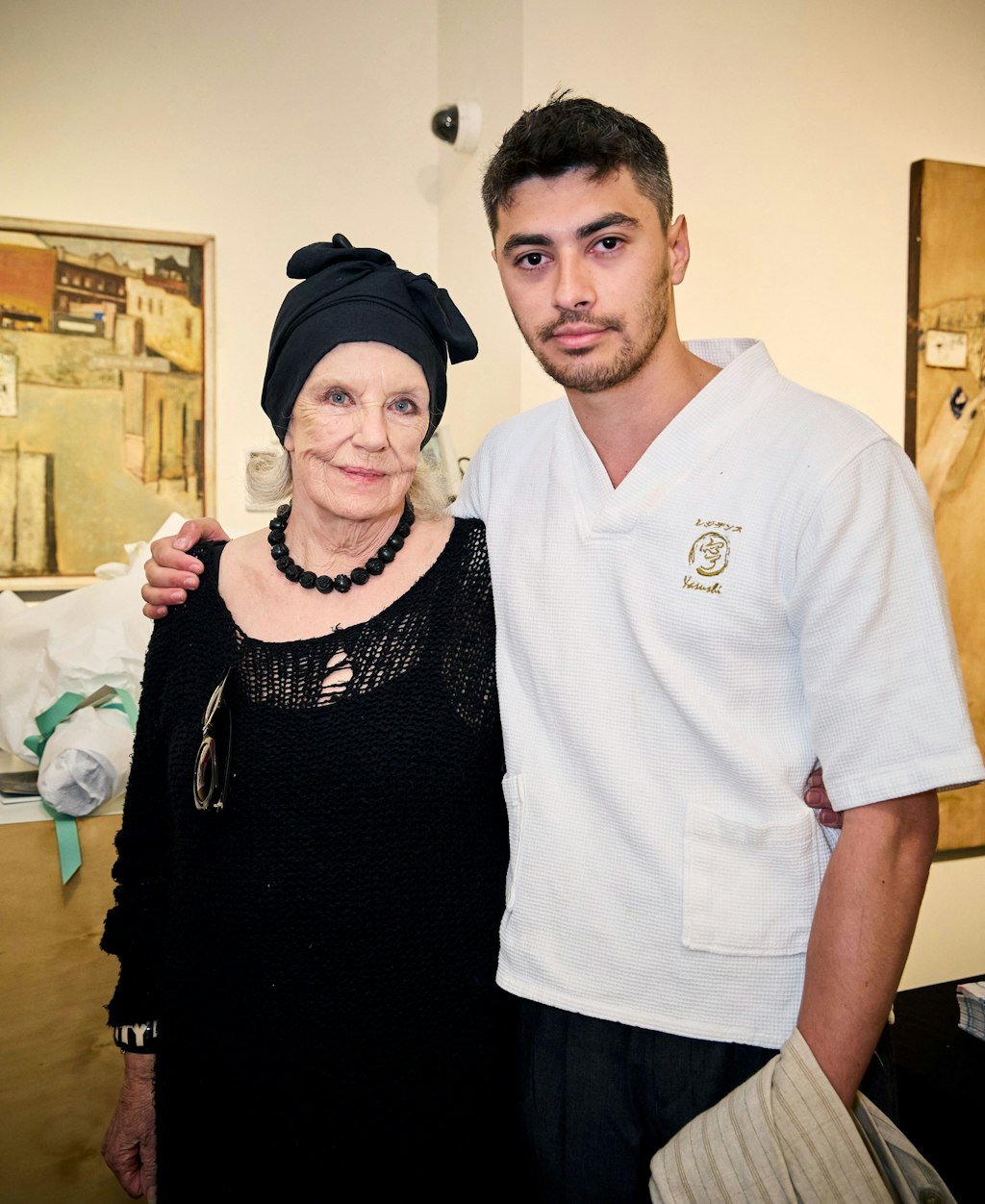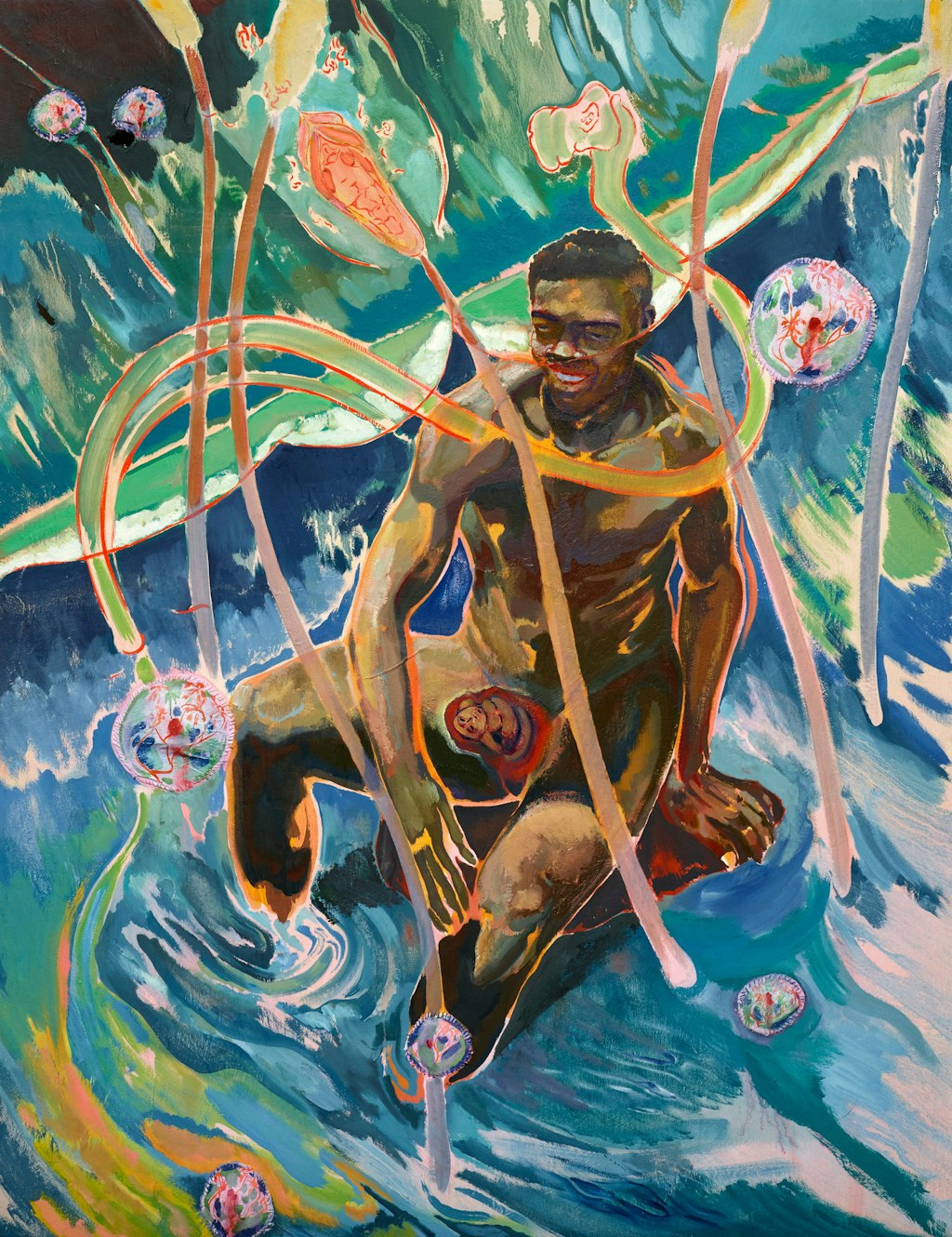The art that made me: Mark Maurangi Carrol
In The art that made me, artists discuss works in the Art Gallery of New South Wales collection that either inspire, influence or simply delight them.

Wendy Whiteley (left) and Mark Maurangi Carrol (right) at the Brett Whiteley Travelling Art Scholarship announcement in 2023 at the Brett Whiteley Studio, Surry Hills
Wendy Whiteley (left) and Mark Maurangi Carrol (right) at the Brett Whiteley Travelling Art Scholarship announcement in 2023 at the Brett Whiteley Studio, Surry Hills
Sydney-based artist Mark Maurangi Carrol is the recipient of the 25th annual Brett Whiteley Travelling Art Scholarship, which is open to artists aged between 20 and 30. In July 2024, he will start a three-month residency at Cité Internationale des Arts in Paris. He also receives $50,000 in funding to further his art education while in Europe.
‘To be afforded the chance to continue my artistic practice abroad within such a culturally and historically significant place as Paris is a great undertaking,’ Carrol says. ‘This opportunity will provide me with ample time to work uninterrupted, free from my usual balance of working part-time and painting in between. It marks my first trip to Europe, offering me the chance to witness in person many works of art I studied as a student.
‘I hope that the time and funds generously allocated to me will provide the momentum to pursue my artistic practice full time in the future. Furthermore, the time spent in Paris will offer me the opportunity to establish stronger relationships with galleries in France and across Europe. This may open the possibility of showcasing my work outside of Australia.’
Carrol, 28, was chosen for the Paris sojourn – from 181 entries – by guest judge Guido Maestri, who won the 2009 Archibald Prize. Maestri says he finds Carrol’s work ‘captivating and unique both in its physicality and conception. Here is a young artist exploring his identity, culture and history in a most thoughtful, delicate and mature way.’
Here Carrol reflects on the artworks that have helped inspire and shape his career to date.
Michael Armitage Man in the waves 2019

Michael Armitage Man in the waves 2019, Art Gallery of New South Wales © Michael Armitage
Michael Armitage Man in the waves 2019, Art Gallery of New South Wales © Michael Armitage
Michael Armitage’s Man in the waves, a recent addition to the Art Gallery of New South Wales collection, was my first choice when I was invited to contribute to The Art That Made Me. This painting is large in scale, measuring 220 x 170 cm. Armitage intentionally employs the historical portrait scale to evoke the familiarity of figurative studies and paintings widely recognised across the arts, particularly within the Western canon of painting. Both the palette and execution of the painting are vibrant, featuring a male nude seated prominently within the picture plane, surrounded by a tumultuous sea. Armitage draws inspiration from a 1913 painting titled Three bathers by German expressionist artist Ernst Ludwig Kirchner. In a deliberate departure, Armitage replaces the dominant female nude with a male nude, challenging historical stereotypes and tropes. One of the compelling reasons behind my selection of this work lies in its nuanced response and distillation of popular culture and personal memory. Armitage achieves this through the materiality of the painting; the pigment is worked into lumbago bark cloth, a material closely associated with East African cultural expression and ritual. The lumbago cloth, worn by the Buganda people of Uganda during ceremonies, also serves as a burial shroud.
Louise Bourgeois Arched figure 1993, cast 2010

Louise Bourgeois Arched figure 1993, Art Gallery of New South Wales © The Easton Foundation/VAGA, NY, Copyright Agency
Louise Bourgeois Arched figure 1993, Art Gallery of New South Wales © The Easton Foundation/VAGA, NY, Copyright Agency
I first encountered Louise Bourgeois’ work in person shortly after I left art school and, as is so often characteristic of her work, she doesn’t let you forget the encounter. The images stay with you for months, even years, after that initial experience. The Australian art scholar and curator Lynne Cooke characterises Bourgeois’ practice as possessing ‘dual threads’: one delving into the psychic and corporeal structures of the body; the other engaging with the charged spaces created for mental and physical refuge. Bourgeois’ exploration of these contrasts is particularly evident in Arched figure. This bronze sculpture portrays the upturned torso, waist and legs of a male figure bent inward at the extremities toward a bed. The simplicity of the bed is notable, resembling an archaic barracks rack or field hospital gurney. The sculpture exudes tension, palpably conveyed through the arching body. It serves as a poignant depiction of discomfort – an inversion of the bed’s customary role as both a symbol and a place of rest. Arched figure challenges conventional expectations, offering viewers a thought-provoking exploration of the complex interplay between the body and its surrounding spaces.
Jenny Watson Wings of desire 2 1989

Jenny Watson Wings of desire 2 1989, Art Gallery of New South Wales © Jenny Watson
Jenny Watson Wings of desire 2 1989, Art Gallery of New South Wales © Jenny Watson
Jenny Watson characterises her work as ‘urgent, passionate, spare, necessary, psychological, and simple’. The painting titled Wings of desire 2 draws inspiration from the 1987 film of the same name by the German filmmaker Wim Wenders. Watson’s works are expansive, often featuring larger-than human scale figures, notably female ones. They exude energy and evoke the rapid gestures with which they are painted. Watson’s paintings, frequently autobiographical in nature, employ a scale traditionally associated with the historical genre of court portraiture. However, she subverts this narrative by incorporating a faux-naive style, depicting scenes evocative of childhood vulnerability, imagination and memory. One of Watson’s distinctive modes of painterly expression lies in her adept use of text, seamlessly integrated with the raw linen and oil colours. Rather than existing as separate forms of communication, text and visual elements correspond harmoniously within the picture plane.
Phillip Guston East Tenth 1977

Philip Guston East Tenth 1977, Art Gallery of New South Wales © Estate of Philip Guston
Philip Guston East Tenth 1977, Art Gallery of New South Wales © Estate of Philip Guston
‘It has taken me years to come to the conclusion or to the belief that probably the only thing one can really learn is the capacity to be able to change.’ – Philip Guston
Guston’s work has always exerted and will likely continue to exert an enormous influence on my practice and that of many others. I first encountered his 1977 painting East Tenth in 2017. Guston’s work has consistently struck me as a form of archaeological performance. Parts of the picture plane are heavily laboured, while others are left bare, with only the suggestion of pigment left in situ. They are layered in their physicality and psychological weight. A constant push and pull exist between the materials, suggesting an energetic tension. The coloured bottles, on one hand, depict transparent glass vessels; with Guston’s brushwork and cloisonnistic black contours, they sit heavy like lead weights, somehow appearing more structural and immovable than the brick wall behind them. The palette is quintessentially Guston, comprising his usual warm pinks, reds, ochres, greys, whites and blacks. Yet within this ‘limited’ palette, a larger world emerges. Similar to many of Guston’s later works, they incorporate familiar talismanic objects from his childhood, now recognisable to us. Guston’s father, a garbage man, often sold collected objects to supplement his wages. Guston can take objects of the banal, the everyday, and elevate them to the heights of poetry and introspection, reminding us of the essence that underlies those endeavours.
A version of this article first appeared in Look – the Gallery’s members magazine